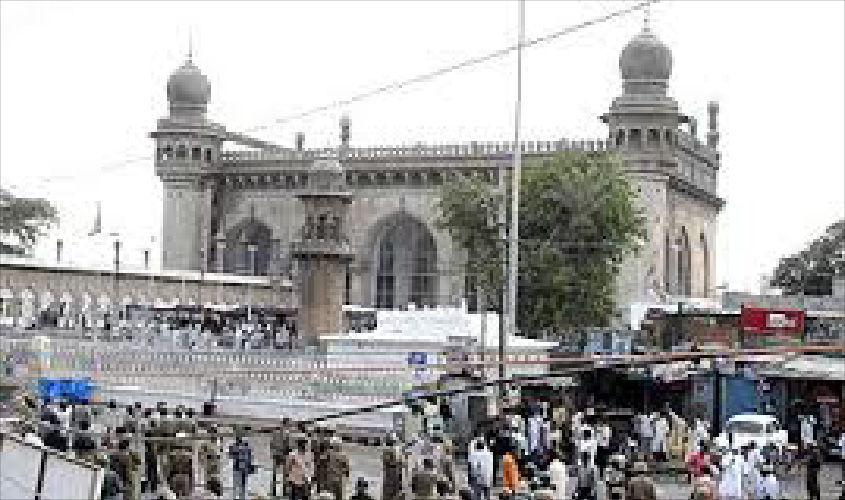The Congress wanted to get closer to Muslims who were alienated after the Babri Masjid demolition in 1992.
A special cell that was set up in the Prime Minister’s Office (PMO) during the UPA II government was more keen on proving that “certain forces” had formed to strike “Hindu terror” in the country than gathering evidence for it. This hurried approach of the UPA government appears to be the reason behind the acquittal of all the five accused in the sensational Mecca Masjid blast case, which killed nine persons and injured 58 others in 2007.
The blasts not only shook the nation, but also triggered subsequent communal violence, leading to police firing that killed another five persons in Hyderabad’s Old City on 18 May 2007.
The case was first dealt with by the Hyderabad police for a month and then transferred to the Central Bureau of Investigation in June 2007 and subsequently to the National Investigation Agency in May 2011.
When a special court of NIA delivered its verdict on 16 April, letting off all the arrested accused—Swami Aseemananda, Rashtriya Swayamsevak Sangh activists Devendra Gupta, Lokesh Sharma, Hindu Vichar Manch activist Bharath Mohan Ratheswar and Rajendra Chowdary—there was a widespread shock that a major terror attack trial ended in acquittals, kicking off hashtags like #noonekilledmeccamasjidblastvictims.
This also looks like a clear case of inefficiency on the part of premier investigating agencies like the CBI and the NIA, but a glance at the twists and turns in the prosecution process over the last 11 years and the views of lawyers, those who appeared for the NIA as well as defence counsels, points to the hurried approach from the top echelons of the then UPA II government that resulted in the acquittals.
Sources in the NIA and Hyderabad police who spoke to The Sunday Guardian said that the previous UPA government was more particular to establish that there was a concerted effort by “certain forces” to unleash “Hindu terror” to counter the Islamic terrorist activities in the country. “It was a top down decision to project a Hindu terror plank,” said a police official on the condition of anonymity.
These police officials and a legal counsel who worked for the NIA two years ago are of the view that the premier investigating agencies were asked to probe along Hindu terror lines, instead of building the case based on evidence gathered against the accused. In a way, the accused were first established and then the cops were directed to gather evidence against them.
This approach, according to those who handled the case over the years, is flawed. The then UPA II government led by the Congress at the Centre was particular that Hindu forces must be implicated beyond a point so that a theory of Hindu terror can be established in the country. This way, the Manmohan Singh led government wanted to get closer to Muslims who were alienated after the Babri Masjid demolition in 1992.
Initially, the Hyderabad police of combined Andhra Pradesh, which was ruled by Y.S. Rajasekhara Reddy’s Congress government, booked cases against some local Muslims and suspected the role of terror outfits like Harkat-ul-Ansar. The police arrested around 100 youth; mostly Hyderabad’s Muslims and took them into judicial custody for a few months.
But along the way, the CBI stumbled upon a line that the blasts could be a handiwork of some Hindu forces who wanted to retaliate Islamic terror through similar blasts and violence in the country. Then, the Hyderabad police were not only asked to release all the arrested youth but were forced to pay a cash compensation of Rs 1 lakh to each of them.
The National Commission for Minorities too stepped in and offered some relief and rehabilitation measures to the Muslim youth who were allegedly “illegally” kept in jail. The UPA government had highlighted this angle and completely excluded Muslims from the probe purview. The CBI fully focused on Aseemananda and others to chase their Hindu terror line.
A former official associated with the NIA investigations told this newspaper that by the time the agency handed over the case to the CBI seven years ago, the investigative agency had almost prepared the charge-sheet against 10 accused, thus eliminating further probe. The NIA’s job mostly confined to gathering evidence against these accused, which was a sort of “backward integration investigation”.
Of the 10 accused, a main witness, Sunil Joshi was murdered six years ago and the CBI could not nab three others—Sandeep Dange, Ramachandra Kalsangara and Amith Chouhan. Interestingly, another accused Tejaram who was accused of transporting the IED bomb from Madhya Pradesh on 17 May 2007 by a bus along with Rajendra Chowdary, was let off on bail as no charge-sheet was filed against him.
The only evidence against Aseemananda was his confession statement before a Delhi metropolitan magistrate in 2012, which was found to be inadmissible before the NIA court as the accused went back on it saying that the NIA had forced him to admit the crime. The NIA court’s additional metropolitan sessions judge Ravinder Reddy on Monday mentioned the poor quality of evidence against the accused.
NIA sources told this newspaper that the agency was unlikely to go for an appeal against the verdict of the special court. However, a decision on this will be taken at the NIA headquarters in New Delhi next week. Meanwhile, NIA special judge Ravinder Reddy’s resignation as well as his leave application have been rejected by the Hyderabad High Court and he attended his duties at Nampally courts on Thursday.

